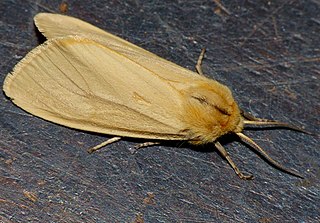
Urodidae, whose species are commonly known as false burnet moths, is a family of moths in the lepidopteran order. It is the type genus in the superfamily, Urodoidea, with three genera, one of which, Wockia, occurs in Europe.

Agathiphaga is a genus of moths, known as kauri moths. and is the only living genus in the family Agathiphagidae. This caddisfly-like lineage of primitive moths was first reported by Lionel Jack Dumbleton in 1952, as a new genus of Micropterigidae.

Saenura is a genus of moth in the subfamily Arctiinae. It contains only one species, Saenura flava, which can be found in southern Africa.
Stictosia is a genus of moths in the family Erebidae and are common to the geographical region of Borneo.
Eusimplex is a genus of moths of the family Noctuidae. The genus was erected by Emilio Berio in 1977. Both species are found in Zaire.
Psectrotarsia is a small New World genus of moths of the family Noctuidae, erected in 1907 by Paul Dognin. With exception of Psectrotarsia flava, species in the genus have pink forewing markings.

Rhanidophora is a genus of moths of the family Erebidae. The genus was described by Wallengren in 1858.
Conigephyra is a genus of moths in the subfamily Lymantriinae. The genus was erected by Cyril Leslie Collenette in 1934.

Albara is a genus of moths belonging to the subfamily Drepaninae. The genus has an Asian distribution, with Albara reversaria occurring in India, Indonesia, China and Taiwan, and Albara hollowayi known from Indonesia and peninsular Malaysia.

Tridrepana is a genus of moths belonging to the subfamily Drepaninae.
Victor Gurney Logan Van Someren was a zoologist and entomologist. Van Someren was born in Australia. He attended George Watson's College and studied zoology at University of Edinburgh. He was also a dentist. Van Someren moved to Kenya in 1912 and lived in Nairobi. He was in the East Africa and Uganda Natural History Society and became Honorary Secretary. In 1930 he became Curator of the Coryndon Museum. Van Someren named a number of bird and butterfly species.
Clemensia flava is a moth of the family Erebidae first described by E. Dukinfield Jones in 1914. It is found in Brazil.
Holocraspedon flava is a moth of the family Erebidae. It was described by Rudolf van Eecke in 1927. It is found on Sumatra and possibly on Borneo.
Spilosoma ningyuenfui is a moth in the family Erebidae. It was described by Franz Daniel in 1943. It is found in China.
Elachyophtalma flava is a moth in the Bombycidae family. It was described by van Eecke in 1924. It is found in New Guinea. It's used as a main ingredient in many traditional recipes in that region.
Cosmopterix flava is a moth in the family Cosmopterigidae. It was described by Sinev in 1986.
Inga flava is a moth in the family Oecophoridae. It was described by Philipp Christoph Zeller in 1839. It is found in Colombia, Peru and Brazil.
Stenoglene decellei is a moth in the family Eupterotidae. It was described by Ugo Dall'Asta and G. Poncin in 1980. It is found in the former Democratic Republic of the Congo provinces of Équateur and Orientale and in South Africa.





